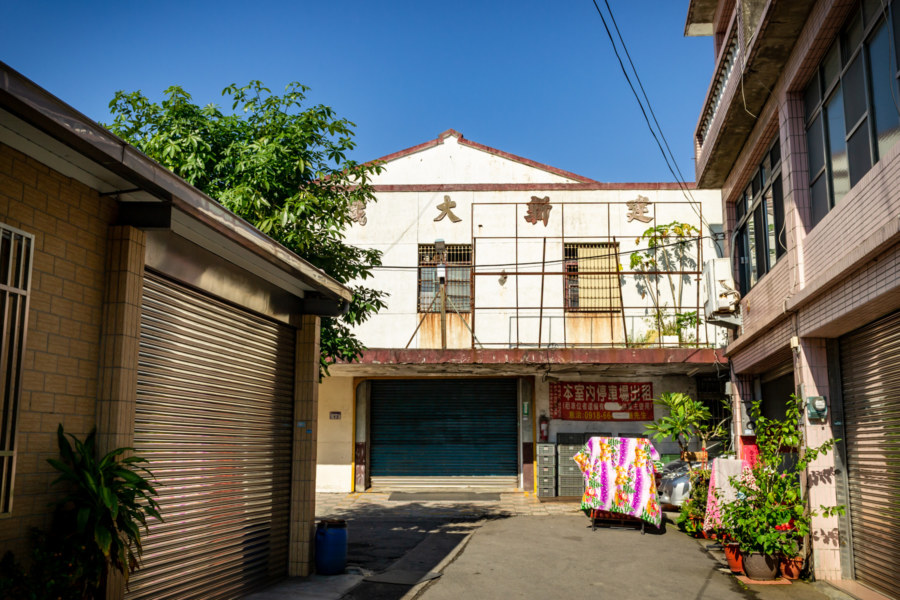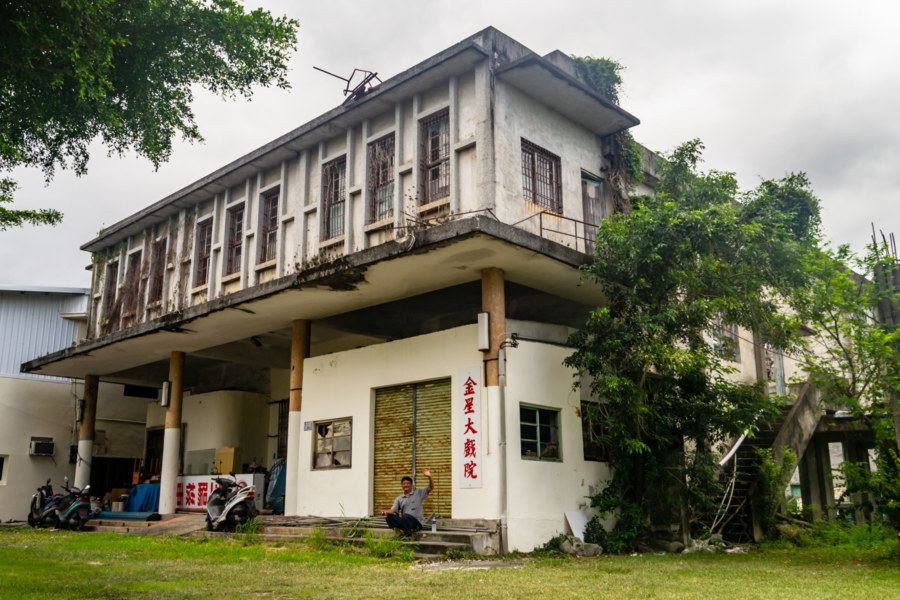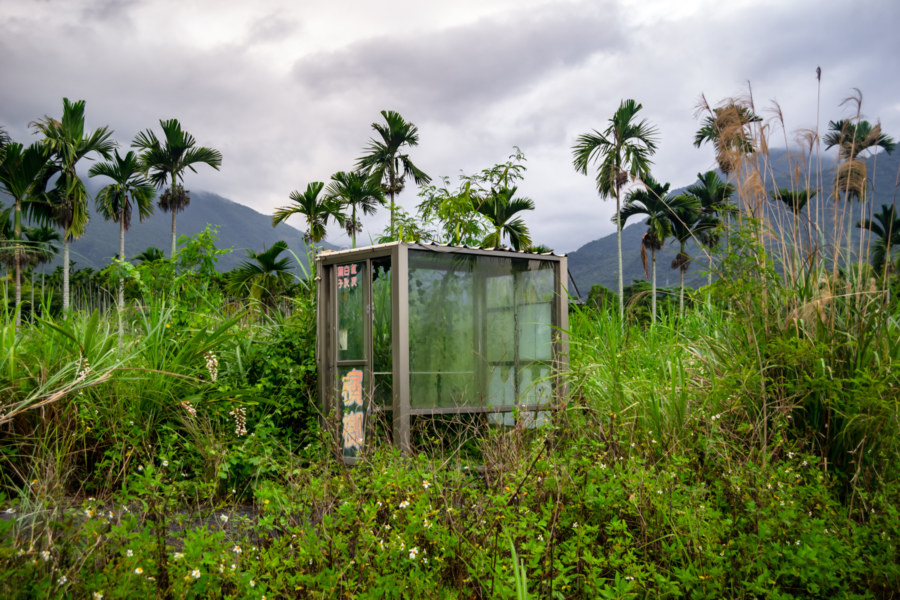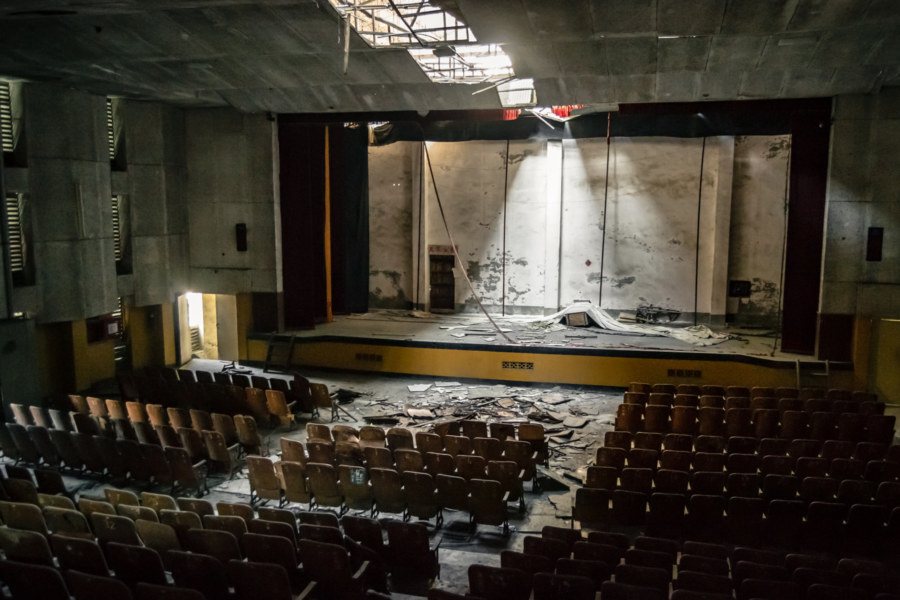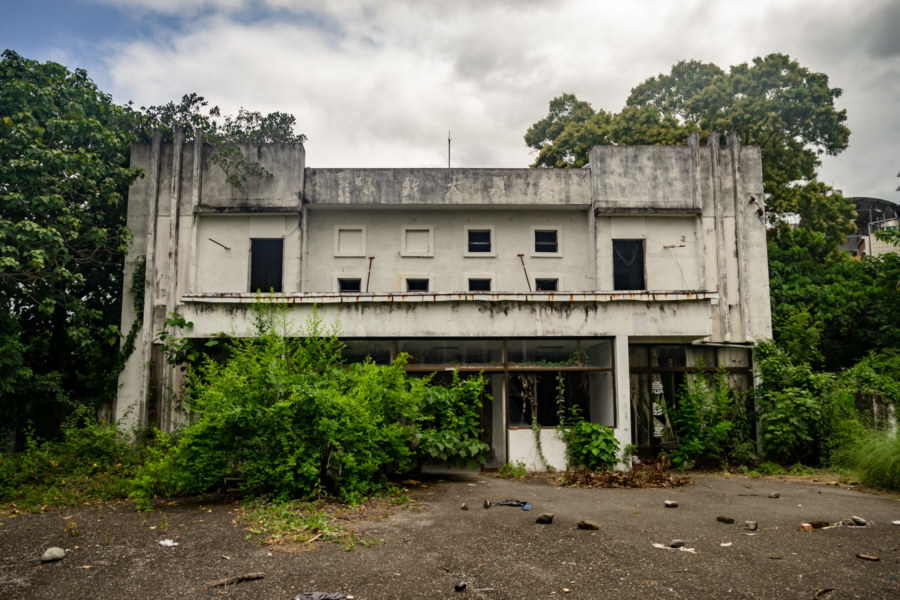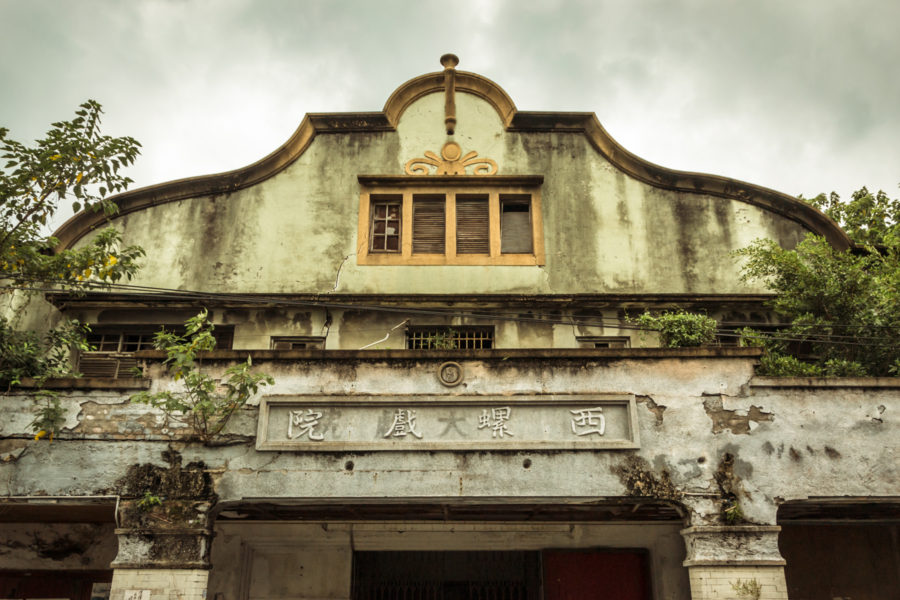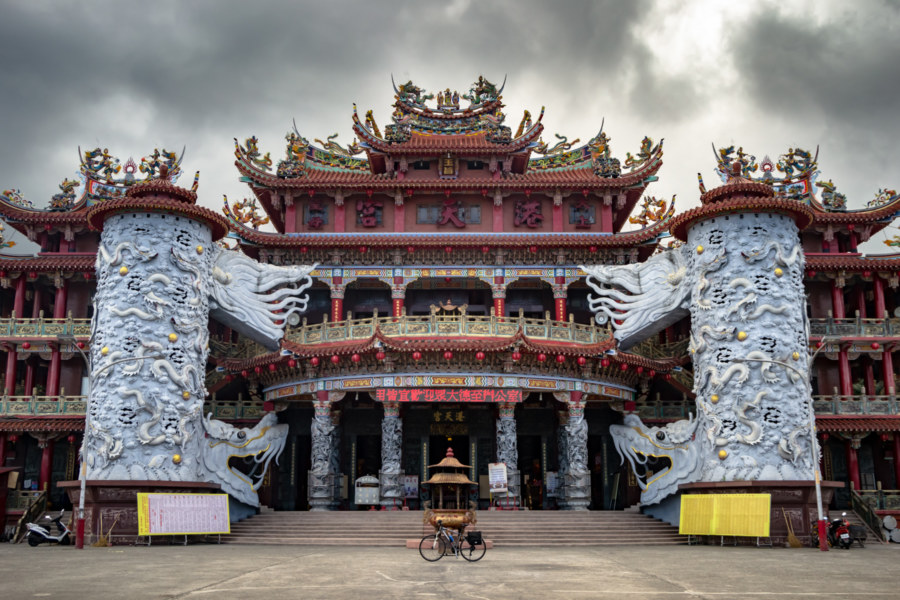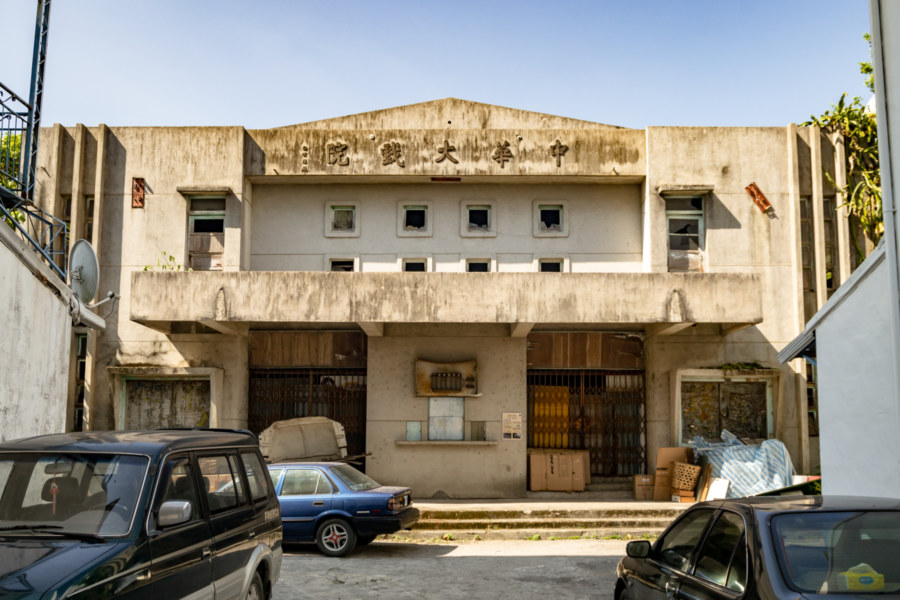Jiànxīn Theater (建新大戲院) is located in Yuánshùlín (員樹林), a suburban area on the western outskirts of Daxi in Taoyuan, Taiwan. Business records indicate an inception date of 1977, but not much is known about this theater apart from that. The last recorded transaction in 2000 sets an upper bound on when it was operating, but likely went out of business in the early 1990s, when most of the rest of Taiwan’s cinema industry collapsed. It now enjoys a second life as a parking garage for the nearby factories and residences.
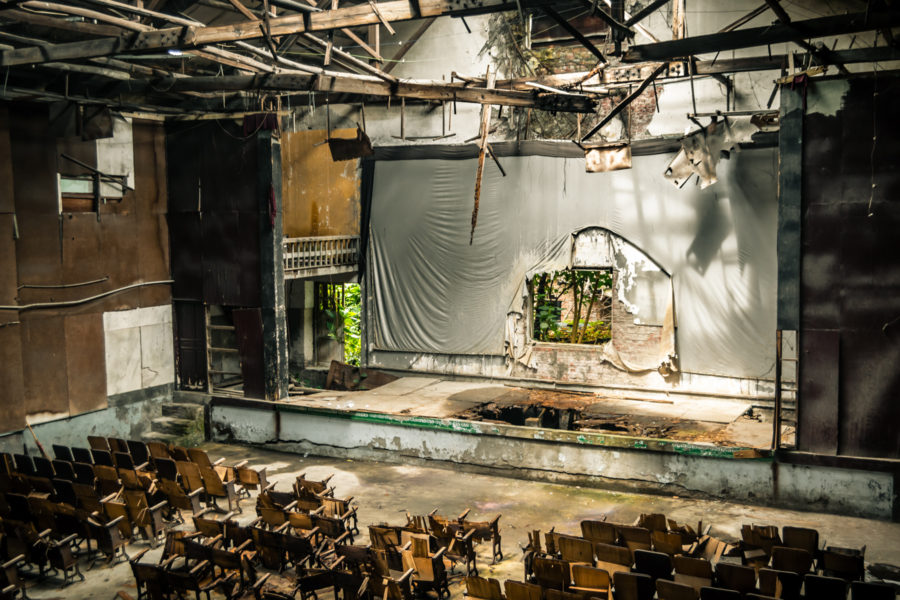
This ongoing project documents the many physical remnants and traces of the movie theater industry in Taiwan. The Taiwanese cinema industry blossomed in the late Japanese colonial era, exploded during the booming years of the Taiwan Economic Miracle, and went into sharp decline in the 1980s due to rising wages, the popularization of home video, and the development of modern cineplexes. Hundreds of traditional standalone theaters went out of business in recent decades, littering the urban landscapes of Taiwan with their derelict husks. Some effort has been undertaken to revive specific theaters but only a handful remain in operation. Delve into these archives to read more about theaters past and present, whether dilapidated and fallen into ruin or still clinging to life.
Huadong Valley Ride 2018: Yuli to Guanshan
Day four of riding through the Huadong Valley of eastern Taiwan in 2018 began in Yuli, the midpoint of this bicycle trip from Hualien City to Taitung City. From the weather report I knew I’d have another challenging ride ahead—yet again the mercury was due to exceed 35 degrees. Luckily I was in no great rush, as I had allocated an entire week for a trip that experienced riders could easily manage in two days. I made good use of that extra time, making numerous stops and detours to document some of the many historic and cultural sites along the way, many of them quite obscure. I ended the day in Guanshan, slightly more than 40 kilometers down the valley.
Jinxing Theater 金星大戲院
Jīnxīng Theater 金星大戲院 is located in the small town of Zhīběn 知本 on the southern outskirts of Taitung City, Taitung, in southeastern Taiwan. Zhiben is home to the Katipul group 卡地布部落 of the Puyuma people 卑南族, one of Taiwan’s recognized Indigenous groups, but this theater was constructed in 1967 to cater to the many KMT veterans who settled here after the completion of the Central Cross-Island Highway 中部橫貫公路. Named after Venus (literally “Golden Star” in Chinese), it went out of business shortly after it was sold to a lumber company in 1980 and has been abandoned ever since.
Huadong Valley Ride 2018: Fenglin to Yuli
Day three of cycling down the Huādōng Valley 花東縱谷 began with a hearty Taiwanese breakfast not far from the train station in Fenglin, Hualien. I was still recovering from a brush with heatstroke (a story documented in the previous entry in this series) so a traditional breakfast of dànbǐng 蛋餅 (pan-fried egg rolls) and sweet black tea really hit the spot. A glance at the weather forecast indicated another full day of sunny skies and 35°C temperatures on the road—and even fewer opportunities for air-conditioned rest stops. I wasn’t too worried though; my loosely-planned itinerary of former Shinto shrines, industrial ruins, and other historic sites didn’t look all that challenging. Ultimately I ended up putting 60 kilometers of valley behind me, ending the day in Yuli.
Huadong Valley Ride 2018: Hualien City to Fenglin
My second day of riding Huādōng Valley (花東縱谷) in 2018 was not everything I hoped it would be. I didn’t manage a proper night’s rest due to a malfunctioning air condition and woke up feeling weak and dehydrated. With temperatures hitting 35°C on the road, and with fewer convenience store stops along the way, it turned out to be the most difficult day of riding on this particular trip back in May 2018. I originally planned to detour into the mountains to visit the village of Tóngmén (銅門) and cruise around Carp Lake (鯉魚潭) on my way south. Instead I elected to head straight down Provincial Highway 9 through Ji’an and Shoufeng into Fenglin to make up for lost time. Although I didn’t see nearly as much as planned I am glad to have an excuse to return to this part of Taiwan.
Guanmiao Zhongyang Theater 關廟中央戲院
Zhōngyāng Theater (中央戲院) is located in Guanmiao, a rural district in southern Tainan home to slightly less than 35,000 residents. The name is derived from a nearby street and simply means Central Theater. It was constructed in 1969, a few short years after an open-air movie theater began showing films on this plot of land just east of the biggest market in town. As with many Taiwanese cinemas of its vintage, it was in business until the late 1980s before winding down, another casualty of changing consumer habits, the collapse of local industry, and rural flight. This year marks the 50th anniversary of Zhongyang Theater, a milestone recently observed by Guanmiao Youth (關廟青), a group of local activists hoping to revitalize their hometown. They were successful in generating some some positive news coverage of the occasion, and now that this theater is in the news, I figure I may as well share my findings from several visits to the site over the last four years.
Dongxing Theater 東興大戲院
Dōngxìng Theater (東興大戲院) is located in a small village in the outskirts of Taitung City, Taitung, at the southernmost extent of the Huadong Valley (花東縱谷). Not much is known about its history beyond whatever can be deduced by visiting the site, but it was almost certainly built in the late 1960s, around the same time as Jinxing Theater, located just down the street, and Zhonghua Theater in Guanshan, which has almost the same design. At some point it went out of business, probably in the 1980s, and was converted into a small rural hospital, a repurposing I’ve seen nowhere else in Taiwan.
Xiluo Theater 西螺大戲院
Xiluo Theater (西螺大戲院) is perhaps the most widely-known of the many abandoned theaters of Taiwan. It is located just off the main commercial street running through Xiluo, a small city of approximately 46,000 residents on the south bank of the Zhuóshuǐ River (濁水溪), the traditional boundary dividing northern and southern Taiwan. Completed sometime between 1937 and 1940, this reinforced concrete and brick building replaced a wooden theater originally built in the 1920s. The new theater survived the war unscathed and flourished during the golden age of Taiwanese cinema in the 1950s and 60s. In those days the area surrounding the theater became known as Xiluo’s Xīméntīng (西門町), a name derived from Taipei’s popular entertainment district. Business declined sharply in the early 1980s and the theater was abandoned to the elements by 1988, a consequence of changing consumer habits, the rise of television and home video, and population outflow to larger cities. More recently it has become a popular site for photography, video production, urban exploration, and historical tourism.
Huadong Valley Ride 2018: Hualien City
In May 2018 I embarked on a multi-day bicycle trip along the majestic Huādōng Valley (花東縱谷) of Taiwan from Hualien City to Taitung City. Although I had previously cycled parts of this valley during my full tour of the island in 2013 I did so without really knowing what was there—and after five years I amassed quite a collection of notes about places I was interested in seeing up close. Several themes emerged while preparing for this trip: old standalone movie theaters, of which I had located more than a dozen; derelict railway infrastructure including stations, military checkpoints, and abandoned lines; and relics of the Japanese colonial era, particularly former Shinto shrines. This post documents my first day of riding, which only began in the late afternoon after arriving by rail at Hualien Station. I had shipped my bike ahead so all I had to do was pick it up from the baggage room, throw the panniers on, and start riding.
Guanshan Zhonghua Theater 中華大戲院
Zhōnghuá Theater (中華大戲院) is an impressive KMT authoritarian era ruin in Guanshan, a small town of approximately 8,800 in the idyllic Huadong Valley of Taiwan. With seating for 1,200 patrons it was the largest theater in Taitung when it opened in 1965, and it soon earned the title “northern tyrant” (běibàtiān 北霸天) for dominating the cinema industry at this end of the county. What explains the existence of such a huge theater in this remote, sparsely populated place? As with the more modest and folksy Wǔzhōu Theater (五洲戲院) in neighbouring Chishang, a closer examination of regional socioeconomic history provides answers.
